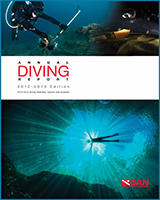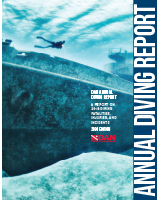This work is available under the terms of the Creative Commons Attribution-NonCommercial-NoDerivs License, which permits use and distribution in any medium, provided the original work is properly cited, the use is non-commercial and no modifications or adaptations are made.
NCBI Bookshelf. A service of the National Library of Medicine, National Institutes of Health.
Trout BM, Caruso JL, Nelson Cet al., authors; Buzzacott P, editor. DAN Annual Diving Report 2012-2015 Edition: A report on 2010-2013 data on diving fatalities, injuries, and incidents [Internet]. Durham (NC): Divers Alert Network; 2015.

DAN Annual Diving Report 2012-2015 Edition: A report on 2010-2013 data on diving fatalities, injuries, and incidents [Internet].
Show detailsSince the DAN “Report on 1987 Diving Accidents” first appeared, DAN has monitored diving deaths, injuries and treatments. Data on diver demographics and diving practices have informed the diving community and identified at risk groups, unsafe behaviors and emerging hazards, for example the rise in lion fish envenomations. In recent years it has become apparent that our average age is increasing and, with that, DAN is receiving more reports of cardiovascular-related fatalities and questions to the Medical Services Call Center concerning cardiovascular matters. The majority of diving fatalities in this report were over 40 years of age and more than half were over 50. Today, perhaps more than ever, fitness to dive is critical in recreational diving. The average Body Mass Index of the fatalities within this year’s report is in keeping with that of the average American, but that should not be grounds for complacency. The demands associated with scuba diving can increase rapidly and unexpectedly. It is when these unexpected demands occur that fit and healthy divers are better equipped to survive than out-of-shape divers or those in poor health.
In this report we consider differences between divers who died while hunting for game such as lobster or spearfishing, and recreational divers in the ocean who were not hunting when they died. It appears the two groups did not differ greatly in physique and that the activity itself may have something to do with the manner of death. Indeed, it appears the ‘hunters’ ran low on, or out of, gas more commonly than the non-hunters. Perhaps the thrill of the hunt distracts divers from checking their air pressure? We cannot say with certainty, but we urge every diver to regularly check their submersible pressure gauge and to monitor their gas reserves.
Rebreathers continue to gain popularity in recreational diving and reports of fatalities involving rebreather divers continue to flow steadily into DAN each year. Human error remains a target for improvement. Likewise, cave diving is another unforgiving diving niche where human error can be fatal. More commonly, however, a cave diving fatality occurs as the result of a collusion of circumstances, all of which conspired to turn a dive fatal. Rarely does a single mistake end a life in cave diving. Often it is a combination of factors, with human error among them.
Outside of caves, freshwater diving is enjoyed by many in the USA. A great number of divers learn to dive in dive parks, quarries, lakes or rivers and in this report we consider the nature of fatalities that occurred at freshwater dive sites. They are often colder at depth than ocean dives, with access to substantial depth relatively close to shore. Divers are reminded that even though freshwater dive sites may appear relatively safe, when there are no waves or current, every dive is made safer by prudent risk management and safe diving practices.
The DAN Medical Services Call Center have been as busy as ever, dealing with the full range of diving emergencies, often in far flung corners of the globe where medical resources may be scarce. Any diver planning a trip to a remote diving destination should consider the added consequences of an injury in such a location. The discomfort associated with a significant delay before evacuation and the costs of treatment should be reason enough to dive conservatively. Insurance can also prove invaluable when injury strikes. Whether a diver is insured or not, the DAN Emergency Hotline is here for you, 24 hours a day, 365 days a year.
In 2010-2013 there were an estimated 57,504,885 Emergency Department admissions in the US and US territories, and 4,368 of those (0.008%) were for scuba injuries, so it should be little surprise if scuba is not a high priority among other national injury monitoring and prevention organizations. DAN takes the lead in this effort. This year the Annual Report contains data on scuba-related Emergency Department admissions. These offer a snapshot of the variety of scuba injuries divers suffer. Future reports will explore additional sources of data from outside of DAN, to assist the reader build a picture of the annual burden of injury attributable to recreational scuba diving.
Also new to the DAN Annual Report this year is a collection of diving incident reports. This initiative collects data from divers who experienced something unexpected, and from these we learn more about the causes of common mishaps such as running out of gas, omitting decompression or unexpected encounters with marine life. We thank everyone who reported an incident and encourage all divers who read this report to visit the DAN website at https://www.diversalertnetwork.org/diving-incidents/ and report the last time you had an incident, whether it resulted in an injury or not.
Our research into the fast growing sport of breath-hold diving continues and this annual report documents the continuing rise in the number of breath-hold fatalities reported to DAN each year. The distribution of ages point to a younger crowd than in scuba diving, and the causes of death also differ. A read of the case summaries will reinforce to all breath-hold divers the value of a “spotter” at the surface and of limiting hyperventilation before diving. Widespread adoption of spotters and limited hyperventilation could significantly reduce the number of breath-hold deaths each year.
Our colleagues in Australia and Japan contribute data on the status in their respective countries and we hope to expand on this next year with an increased global perspective. Countries differ in their climate, sea conditions, regulations for diving, boating and hunting, in their near-shore bottom topography and, indeed, in the people that live there. Much can be learned by comparing diving practices and injuries between regions.
Peter Buzzacott, MPH, PhD
Director, Injury Monitoring and Prevention
- Introduction - DAN Annual Diving Report 2012-2015 EditionIntroduction - DAN Annual Diving Report 2012-2015 Edition
Your browsing activity is empty.
Activity recording is turned off.
See more...
